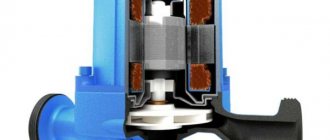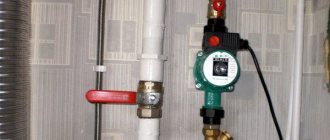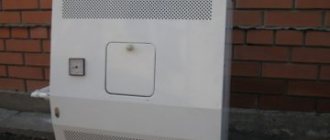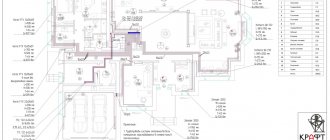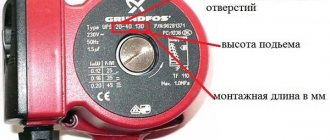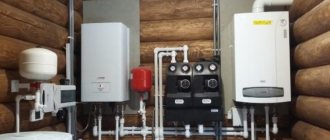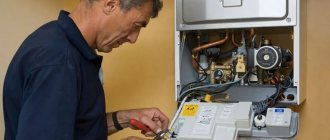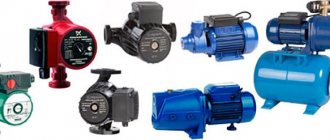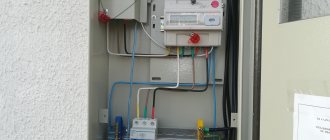The uniform distribution of heat in a house with an autonomous heating system is determined by the model of pumping device used. This equipment ensures the forced movement of a warm medium through pipes and radiators.
To determine which heating pump connection diagram will be optimal for independent implementation, many details must be taken into account. In this article, we will consider in detail possible connection schemes and analyze the connection rules in detail.
We will also pay attention to the subtleties of choosing a location for installation, supplementing the material with thematic photos and diagrams.
What are the benefits of pump heating systems?
30 years ago, so-called steam heating was common in private homes, where the coolant circulated through pipes and radiators by gravity, and the heat source was a gas boiler or wood stove. Pumps for pumping water were used in district heating networks. When compact circulation pumps for heating appeared, they migrated to private housing construction, as they provided the following advantages:
- The speed of coolant movement has increased. The heat generated by the boiler has become faster delivered to the radiators and transferred to the premises.
- Accordingly, the process of heating the house has accelerated significantly.
- The higher the flow rate, the greater the throughput of the pipe. This means that the same amount of heat can be delivered to rooms through lines of smaller diameter. Simply put, the pipelines have become half the size thanks to the forced circulation of water from the pump, which is cheaper and more practical.
- Highways can now be laid with a minimum slope and water heating circuits can be made as complex and extensive as desired. The main thing is the correct selection of the pumping unit in terms of power and pressure created.
- The household circulation pump for heating has made it possible to organize underfloor heating and more efficient closed systems operating under pressure.
- It was possible to remove from view the ubiquitous pipes that run through the rooms and do not always harmonize with the interior. Increasingly, heating communications are laid in walls, under floor coverings and behind suspended (suspended) ceilings.
Note. A minimum slope of 2-3 mm per 1 m of pipeline is needed to empty the network in case of repair or maintenance. Previously, it was made at least 5 mm / 1 m.p.
Pumping systems also have disadvantages. This is a dependence on electricity and its consumption by the pumping unit during the heating season. Therefore, if there are frequent power outages, the circulation pump must be installed together with an uninterruptible power supply unit or connected to an electric generator. The second drawback is not critical; if you select the power of the device correctly, then the electricity consumption will be acceptable.
Leading manufacturers of heating equipment, such as Grundfos or Wilo, have developed new models of units that can save energy. For example, if you buy and install an Alpfa2 circulation pump from the Grundfos brand, it will automatically change its performance depending on the needs of the heating system. True, its price starts from 120 USD. e.
New generation circulation units from Grundfos – models Alpfa2 and Alpfa2L
Wet rotor pumps
In wet modifications, the shaft and impeller are in contact with the pumped resource, and it also serves as lubrication and cooling.
The stator is separated by a special flask that seals parts of the electric motor, otherwise voltage would be transmitted through water to all metal elements of the system.
Components and how they work
Wet central pump design:
- housing that can withstand high pressures is made of cast iron, steel, aluminum. For standard home conditions, this is a small block that is attached directly to the pipe, bypass;
- a shaft (moving segment), also known as a rotor made of steel, ceramics with a bearing unit, a working disk with blades. The latter is fixed motionless, it consists of 2 wheels with holes connected by blades: on one - for moving the resource, on the adjacent one - for securing to the electric motor shaft;
- a stator (fixed unit) on the rotor with an excitation winding (inductor) to stabilize the rotation speed and flow, for which it has small blades at a certain angle. This part prevents flow stalling. This part consists of a core and a frame. In the grooves of the first there is a winding. The stator is also a magnetic circuit and a supporting structure;
- control chip, power terminals. On models without the first element there is a capacitor, and on the contact block there is a speed selector.
When starting, the blade disk rotates, a vacuum is created inside the pipe, the coolant is drawn in and moved by the rotor further along the equipment (from inlet to outlet). Fence and ejection are carried out. Centrifugal force helps move the resource throughout the circuit. The resulting pressure creates the required force on different segments of the pipe line and creates circulation on its rises.
Nuances, pros and cons
Wet circulation pumps, however, like everything else, are usually modular. The devices are selected according to the parameters of the circuit (pressure, required maximum amount of pumped volume). An important plus is that the device is prefabricated, which simplifies its repair; broken parts are replaceable.
Wet central heating systems are installed on the vast majority of home systems, this is the standard, and here’s why:
- the device is almost silent, which is suitable for living, for better comfort;
- compactness, light weight - the device is a small box that does not require special fastening, partitions, or space on the floor. The product simply crashes into the pipe and “hangs” on it;
- there is no need for additional cooling (unlike dry models), this function is performed by the water flowing inside;
- There are fewer spare parts, the ability to replace them, easy repairs, dismantling, minimal maintenance frequency;
- wide range of settings;
- long-term performance if there is a filter and working fluid without fine particles;
- cheaper if the device is for low standard productivity.
Disadvantages for home heating with a wet pump:
- if the water contains fine abrasive particles (lime, iron, etc.), then the impeller and other parts (hydraulics) in contact with the liquid will wear out relatively soon and fail. For such products, a closed system with a purified resource is recommended; a dirt filter is mandatory;
- low efficiency - about 55%;
- the performance range is more limited than dry options. But it is enough to service the average private home, therefore, and also because of the low price, it is often used for housing.
Where to install the pump - supply or return
Despite the abundance of information on the Internet, it is quite difficult for the user to understand how to correctly install a heating pump in order to ensure forced circulation of water in the system of their own home. The reason is the inconsistency of this information, which causes constant debate on thematic forums. Most of the so-called specialists claim that the unit is installed only on the return pipeline, citing the following conclusions:
- the coolant temperature in the supply is much higher than in the return, so the pump will not last long;
- The density of hot water in the supply line is less, so it is more difficult to pump;
- The static pressure in the return line is higher, which makes the pump easier to operate.
Interesting fact. Sometimes a person accidentally ends up in a boiler room that provides central heating for apartments, and sees the units there embedded in the return line. After this, he considers this solution to be the only correct one, although he does not know that in other boiler houses centrifugal pumps can also be installed on the supply pipe.
We respond to the above statements point by point:
- Household circulation pumps are designed for a maximum coolant temperature of 110 °C. In a home heating network it rarely rises above 70 degrees, and the boiler will not heat the water more than 90 °C.
- The density of water at 50 degrees is 988 kg/m³, and at 70 °C – 977.8 kg/m³. For a unit that develops a pressure of 4-6 m of water column and is capable of pumping about a ton of coolant in 1 hour, the difference in the density of the transported medium is 10 kg/m³ (the volume of a ten-liter canister) is simply negligible.
- In practice, the difference in static pressure of the coolant in the supply and return lines is equally insignificant.
Hence the simple conclusion: circulation pumps for heating can be installed both in the return and supply pipelines of the heating system of a private house. This factor will not in any way affect the performance of the unit or the heating efficiency of the building.
Boiler room made by our expert Vladimir Sukhorukov. There is convenient access to all equipment, including pumps.
The exception is cheap solid fuel direct combustion boilers that are not equipped with automation. When overheated, the coolant in them boils, since burning wood cannot be extinguished at once. If the circulation pump is installed on the supply side, then the resulting steam mixed with water enters the housing with the impeller. The further process looks like this:
- The impeller of the pumping device is not designed to move gases. Therefore, the performance of the device decreases sharply, and the flow rate of the coolant drops.
- Less cooling water enters the boiler tank, causing overheating to increase and even more steam to be produced.
- An increase in the amount of steam and its entry into the impeller leads to a complete stop of the coolant movement in the system. An emergency situation occurs and, as a result of an increase in pressure, a safety valve is activated, releasing steam directly into the boiler room.
- If no measures are taken to extinguish the firewood, the valve cannot cope with the pressure release and an explosion occurs with the destruction of the boiler shell.
For reference. In cheap heat generators made of thin metal, the response threshold of the safety valve is 2 Bar. In higher quality TT boilers, this threshold is set at 3 Bar.
Practice shows that no more than 5 minutes pass from the start of the overheating process to the valve activation. If you install a circulation pump on the return pipe, then steam will not enter it and the time period before an accident will increase to 20 minutes. That is, installing the unit on the return line will not prevent an explosion, but will delay it, which will give more time to fix the problem. Hence the recommendation: it is better to install pumps for boilers running on wood and coal on the return pipeline.
For well-automated pellet heaters, the installation location does not matter. You will learn more information on the topic from our expert’s video:
Design features
Products from German manufacturers can work for a very long time without maintenance. And all because durable and reliable materials are used in its production. For example, the body of the product is made of durable gray cast iron. Inside it is a stainless steel shaft. It is secured using bearings made of graphite. The fluid supply speed has three-stage adjustment. In this case, the maximum possible coolant temperature parameters can reach +110 degrees Celsius. In industrial models, this ceiling may increase.
Note! The described pump is also designed for very high operating pressure. Standard products used in everyday life can withstand a pressure of 10 bar
Industrial designs in special designs can withstand pressures of 16 bar.
Installation diagrams in various types of systems
To begin with, let’s clarify the place where to install the flow pump, which circulates water through the boiler and forcibly directs it to the radiators of the heating system. According to our expert Vladimir Sukhorukov, whose experience is trustworthy, the installation location must be chosen in such a way that the unit is convenient to maintain. On the supply side it should be located after the safety group and shut-off valves, as shown in the installation diagram:
In order for the unit to be removed and serviced, shut-off valves must be installed on the sides
On the return line, the pump must be placed directly in front of the heat generator, and in tandem with a filter - a mud trap, so that you do not have to buy and install extra taps. The wiring diagram for the pumping unit looks like this:
When installing on the return line, it is better to place the mud collector in front of the pump unit
Recommendation. A circulation pump can be installed in this way in both a closed and an open heating system, there is not much difference. The statement also applies to the collector system, where the coolant moves to the radiators through separate connections connected to the distribution comb.
A separate issue is an open heating system with a circulation pump, capable of operating in 2 modes - forced and gravity. The latter is useful for homes where power outages often occur, and the owners’ income does not allow them to buy an uninterruptible power supply unit or a generator. Then the device with shut-off valves must be installed on the bypass, and a tap must be inserted into a straight line, as shown in the diagram:
This scheme can operate in forced and gravity mode
Important point. On sale there are ready-made bypass units with a pump, where instead of a tap on the flow there is a check valve. Such a solution cannot be called correct, since a spring-type check valve creates a resistance of the order of 0.08-0.1 Bar, which is too much for a gravity heating system. Instead, you can use a petal valve, but it must be installed only in a horizontal position.
Finally, we will explain how to install and connect a circulation pump to a boiler that burns solid fuel. As mentioned above, it is better to place the unit on the line coming from the heating system to the heat generator, as shown in the diagram:
As you can see, the piping uses a pump connection to the boiler circulation circuit with a bypass and a three-way mixing valve. The important role of these piping elements is described in detail in the manual on connecting solid fuel boilers.
What is important to know?
The wiring diagram and methods of connecting a device such as a circulation pump to electricity can have different designs. The choice of a specific option is determined by the characteristics of the heated object, as well as the location where the device is located. There are two ways to connect it:
- direct connection to a 220 V power supply;
- connection to an uninterruptible power supply, which in turn is connected to a 220 V or 220/380 V network (in the case of a three-phase UPS).
By choosing the first method, the consumer risks being left without heating in the event of a prolonged power outage. This option can be considered justified only if there is a high degree of reliability of power supply, reducing the likelihood of a long power outage to a minimum, and also if there is a backup source of electrical energy at the site. The second method is preferable, although it requires additional costs.
Installation rules
The design of a household circulation pump from any manufacturer provides for its fastening to pipelines or shut-off valves using union nuts (American). This allows it to be quickly dismantled if necessary, for example, for replacement or repair. When installing the pump unit, follow these recommendations:
- Place the device on any sections of pipelines - horizontal, vertical or inclined, but with one condition: the rotor axis must be in a horizontal position. That is, installation “head down” or up is unacceptable.
- Please note that the plastic box with electrical contacts is located on top of the case, otherwise it will be flooded with water in the event of an accident. Yes, and servicing the product will not be easy. This is easy to achieve: unscrew the screws securing the casing and turn it to the desired angle.
- Remember to follow the flow direction indicated by the arrow on the housing.
- So that the product can be removed without emptying the system, install shut-off valves before and after it, as shown in the diagrams in the previous section.
A visual aid showing what position the pump unit should be in
Advice. It so happened that the load from the weight of the circulation unit will fall on 1 or 2 ball valves (depending on the orientation of the area in space). Hence the recommendation: do not save money and buy high-quality shut-off valves, whose body will not crack over time from mechanical stress.
Basic safety rules
Although the design of the circulation pump is quite simple, it will require certain qualifications to eliminate any breakdowns that occur. Therefore, it is easier to prevent a problem than to heroically eliminate it later. One sign that something is wrong with your equipment is if it becomes excessively hot during operation.
Compliance with the simplest operating rules will help prevent this:
- Under no circumstances should the wiring come into contact with moisture.
- Particular care should be taken to check the tightness of the connection between the pumping equipment and the pipeline. If there are leaks, the gaskets should be replaced.
- It is forbidden to turn on the device without first grounding it. The heating pump device includes special terminals.
- The internal pressure force should not exceed operating standards.
To figure out why the heating pump is not working, it is recommended to seek help from a professional technician. You can try to fix simple problems yourself.
About installing additional units
As a rule, in a closed or open radiator heating system, where the heat source is a single boiler, it is enough to install one circulation pump. In more complex schemes, additional units are used for pumping water (there may be 2 or more of them). They are placed in the following cases:
- when more than one boiler installation is used to heat a private house;
- if a buffer tank is involved in the piping scheme;
- the heating system has several branches serving various consumers - radiators, heated floors and an indirect heating boiler;
- the same, using a hydraulic separator (hydraulic arrow);
- for organizing water circulation in underfloor heating circuits.
Correct wiring of several boilers operating on different types of fuel requires that each of them have its own pumping unit, as shown in the diagram for the joint connection of an electric and TT boiler. How it functions is described in our other article.
Connecting an electric and TT boiler with two pumping devices
In a circuit with a buffer tank, it is necessary to install an additional pump, because it involves at least 2 circulation circuits - boiler and heating.
The buffer tank divides the system into 2 circuits, although in practice there are more of them
A separate story is a complex heating scheme with several branches, implemented in large cottages with 2-4 floors. Here, from 3 to 8 pumping devices can be used (sometimes more), supplying coolant floor by floor and to different heating devices. An example of such a circuit is shown below.
Finally, a second circulation pump is installed when heating the house with water-heated floors. Together with the mixing unit, it performs the task of preparing coolant with a temperature of 35-45 ° C. The operating principle of the circuit presented below is clearly described in a separate material.
This pumping unit forces coolant to circulate through the heating circuits of underfloor heating.
Reminder. Sometimes pumping devices do not need to be installed for heating at all. The fact is that most electric and gas wall-mounted heat generators are equipped with their own pumping units built inside the housing.
Electrical repair
The electrical part of the pump includes the following components:
- inductor;
- starting capacitor;
- connecting wires;
- control terminal.
If the stator winding breaks down, the pump becomes unrepairable; all other components can be repaired or replaced. To analyze the condition of electrical parts, you will need an ohmmeter.
Photo of the circulation pump Wilo MTSL 15/5 HE – 2.
Main symptoms of malfunction
If the boiler display shows an error code corresponding to a water circulation problem, and it is not reset, the problem may be hidden in the electronic part of the device.
Circulation pump with cover removed.
To identify the problem you must:
- Turn off the heating mode in the boiler, and after stopping all components, turn off the power (soft stop).
- Open the front panel of the case.
- If the pump is covered with a large layer of dust, clean its surface.
- Using the information in the diagram, remove the control terminals and remove the terminal with the capacitor.
- Visually examine the condition of the pump contacts and terminals; they should be free of oxides, burnouts and mechanical damage.
- Using a tester in diode testing mode, determine the integrity of the connecting wires that go from the control board to the pump.
- Use an ohmmeter to determine the resistance of the inductors. On a working device, the instrument readings on the contacts will correspond to the following values:
- No. 1, 4 – 150 – 160 Ohm;
- No. 1, 6 – 290 – 300 Ohm;
- No. 2, 3 - 0 (contacts connected together);
- No. 3, 5 – 220 -230 Ohm;
- No. 4, 6 – 150 – 160 Ohm.
- The device will be considered faulty if the ohmmeter reading on any of the above pair of marks is 1 (winding wire break) or 0 (short circuit, except for contacts 2,3).
- Check the condition of the starting capacitor. To do this, switch the tester regulator to the 20 microfarad capacity test mode. Connect the probes of the device to the terminals of the capacitor and determine its capacitance. It should match the nominal ± 10%. Loss of capacity leads to a decrease in pump performance; it will emit an uncharacteristic hum.
Electrical diagram of the pump Wilo MTSL 15/5 HE – 2.
Measuring the resistance of the circulation pump windings.
Connecting the circulation pump to the electrical network
There are several ways to connect power to the device:
- through a conventional differential machine;
- with thermostat control;
- connection to the network together with an uninterruptible power supply unit (UPS);
- powering the unit from the boiler automation.
Warning. Often, homeowners simply plug the pump into a regular outlet, connecting the wires to a purchased plug. We cannot recommend this approach, because connection without grounding and a safety device is dangerous. If there is a problem with the device or if it is filled with water, you risk receiving an electric shock.
Typical connection diagram with a differential circuit breaker
The first connection diagram is quite simple and any user can assemble it with his own hands. You will need an 8 A differential circuit breaker, wires and contacts. Connect to grounding both in this circuit and in all others.
To automatically stop the movement of the coolant when cooling to a certain temperature, an electrical circuit is used to connect a circulation pump with a thermostat. The latter is attached to the supply pipeline and breaks the power supply circuit when the water temperature drops below a set value.
Connecting a phase wire to the pump through an overhead thermostat
Attention! To ensure that the thermostat does not lie and turns off the circulation in time, it must be attached to a metal section of the line. Polymers do not transfer heat well, so when mounted on a plastic pipe, the device will not work correctly.
There are no difficulties in connecting the power supply through a UPS, for which the latter has special connectors. The heat generator itself should also be connected to them if it needs electricity. But connecting the pump to the boiler control panel or to its automation is a more complicated procedure. It is advisable to have knowledge and skills in the field of electrical engineering.
The boiler is also connected to the uninterruptible unit if it needs electricity
Circulation device and boiler operating on solid fuel
Here the pump is connected to the system on the return branch and connected with a mixing valve and bypass to the boiler circuit. The three-way valve can be equipped with a servo drive and a clamp-on temperature sensor. Since heating devices operate at full power only in the cold season, you can install a heat accumulator that can absorb excess heat and then, upon request, return it to the heating system. On the battery, on one side there are two pipes for connecting it and two on the other side for connecting to the radiator branch.
At what speed should the pump in the heating system operate?
The purpose of forced circulation is to effectively heat the house through the reliable delivery of heat to all consumers of the system, right up to the furthest radiator. To do this, the pumping unit must develop the required pressure (otherwise known as pressure), which is ideally calculated by design engineers based on the hydraulic resistance of the pipeline network.
Most household pumps have from 3 to 7 rotor speeds, due to which the performance and pressure generated can be increased or decreased. In order not to torment you with hydraulic calculations, we offer the following method for selecting the optimal speed:
- Find a laser surface thermometer (pyrometer). Put the heating system into operating mode.
- Measure the surface temperature of the pipe at the inlet and outlet of the boiler.
- If the temperature difference is more than 20 °C, increase the rotor speed. After 30 minutes, repeat the measurement.
- When the temperature difference is less than 10 °C, the water flow rate must be reduced. The goal is to achieve a delta between supply and return of about 15 °C.
The minimum number of rotor speeds is 3, but sometimes 7 or more
Advice. Do not switch the pump to a different circulation speed “on the fly”. Disconnect it from the network, move the regulator to a different position, and then put it back into operation.
You can do without a pyrometer when thermometers are installed on the supply and return lines. If the adjustment limits do not allow you to enter the range of 10-20 °C temperature difference, your system is not working efficiently due to an incorrectly selected circulation pump. Too cold return water increases the load on the boiler and increases fuel consumption. Water that is too hot means that it flows too quickly and does not have time to transfer heat to the heating devices.
The leading European brand Grundfos offers the latest generation Alpfa3 circulation pumps, which can independently select performance depending on the load and thus adapt the work to changing conditions. With their help, you can even balance the heating system, which our expert will tell you about in the next video:
Mechanical damage
Although if the circulation pump breaks down, you need to contact a specialized service, some problems can be fixed yourself. For example, if the equipment makes noise and vibrates during operation, it means that one of the bearings is worn out. You can replace it yourself: these parts are sold in any city, and you can find out the required standard sizes of the part by looking at the technical data sheet of the unit.
If a sharp noise is heard when the device is turned on, this indicates the presence of air in the flow part of the pipeline. If the coolant level is minimal, the pump may be damaged, especially if the unit is equipped with a “wet” rotor. The solution to the problem is to bleed air from the heating circuit and install an air vent at the highest point of the piping assembly.
Sometimes the noise when turned on is accompanied by strong vibration, which indicates low pressure in the suction pipe. In this case, you just need to increase the pressure on this section of the pipeline.
Additional options
If the repair does not help and the pressure remains weak, it means that the pump is installed incorrectly, so that the impeller rotates in the opposite direction. It is also possible that the circulation ring has high hydraulic resistance. Then the pump filter must be cleaned, and then the diameters of the pipelines and control valves must be checked.
A long-used pump may start without noise or vibration, but stop working after a while. The reason for this is the presence of lime deposits between the stator “jacket” and the rotor, which are formed due to increased water hardness. The best way to get rid of the problem is to disassemble the pump and clean all parts. At the same time, inspect the water heating boiler: liquid with a high salt content could also cause damage.
Often the pump turns on, but its shaft cannot rotate. This means that the part is blocked by a foreign object or has oxidized due to prolonged inactivity. In the first case, it is enough to dismantle the electric motor block of the circulation pump and remove the object. In the second, everything is also simple: to perform repairs, you need to turn the wheel by hand or with a screwdriver.
Remember: before removing the engine, you must disconnect the motor from the power supply and drain the water from the unit.
Solving power problems
There is another reason why the pump shaft does not rotate - problems in the electrical circuit. In such a situation, it is necessary to check the supply voltage, which must correspond to the passport data, the presence of all phases and the correct connection of the terminals.
Checking the phases is also necessary to eliminate such a problem as the activation of external motor protection immediately after starting the unit. Sometimes the cause of blocking is the lack of phase grounding. If not, it is recommended to inspect the fuse contacts: they may be dirty or open.
Due to the modular design of the pumps, faulty parts of the electrical circuit can be easily replaced. The required characteristics of the components are indicated in the technical data sheet of the device.
